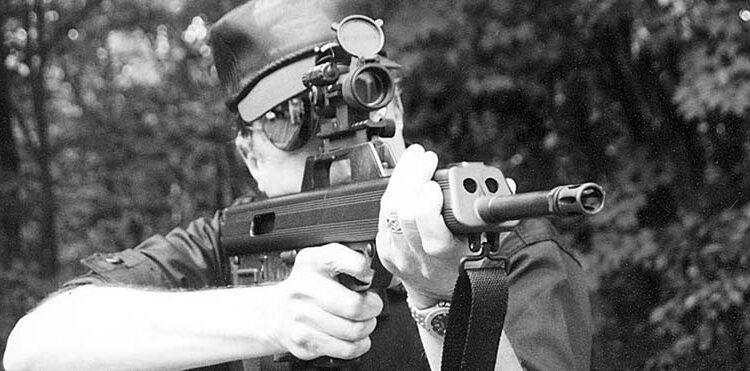By Charles Q. Cutshaw
Most civilians and law enforcement agencies that equip themselves with 5.56x45mm carbines, choose a semiautomatic AR-15 – type firearm, although the Ruger Mini-14 is also a favorite. Carbines are usually purchased from one of the major manufacturers of AR-15 – type firearms, Armalite, Bushmaster and Colt, to name a few. There are other 5.56x45mm carbines available, however, and it is Bushmaster’s non-AR15 rifle that is the subject of this evaluation.
The Bushmaster M17S is not well – known and generally is not even considered by either civilian or law enforcement purchasers, primarily because Bushmaster has not given the little rifle wide publicity. When questioned by the author, Bushmaster’s spokesman stated that orders for their AR-15 – type rifles and carbines had been so heavy that the firm hadn’t been able to publicize the M17S as widely as they would have liked, despite the fact that the M17S may well be better suited for those situations demanding a compact 5.56mm NATO carbine than any version of the AR-15. This is a strong statement, but the author has over 30 years’ experience with AR-15 and M16 type weapons, plus other Stoner weapons and the fact is that Eugene Stoner designed several other rifles that were fundamentally superior to his AR-15 in their basic design. The M17S is derived from one of these superior designs, the AR-18.
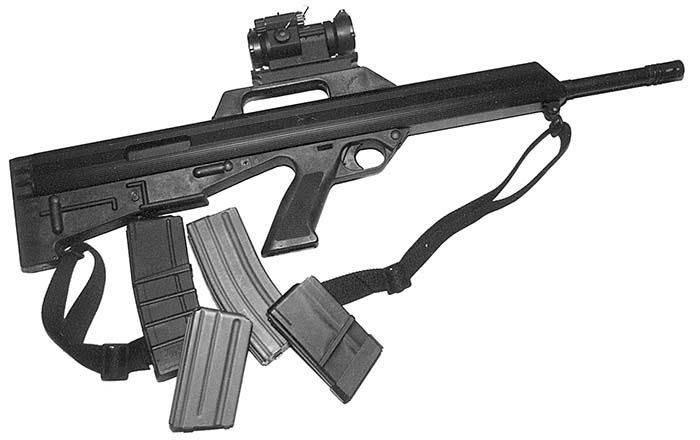
Although it is a bullpup, the operating system of the M17S is almost identical to that of the Armalite AR-18 and semiautomatic only AR-180 of the 1970s. The AR-18 was never fully developed because the US military had already committed itself to the AR-15. Without entering into a full technical analysis of the two designs, there are fundamental differences between them. Everyone who has ever used an AR-15 or M16 is keenly aware that the rifle requires a great deal of maintenance and is a “dirty” weapon. This is because excess gases and carbon are vented back into the receiver from the gas tube as the bolt carrier moves to the rear. Carbon from these hot gases essentially “plates” onto several portions of the bolt carrier and the interior of the receiver and after a few rounds are fired, the entire interior of the rifle is coated with a film of carbon. If allowed to build up, this carbon will eventually lead to stoppages, so the rifle must be cleaned frequently. A second problem with the AR-15 design is that the bolt carrier rides directly on the interior surface of the receiver. Because of the ever-present carbon fouling, most operators keep the bolt carrier well-lubricated, which turns it into a “dust magnet” unless the ejection port cover is kept closed at all times when the rifle is not in use. Excess dirt will cause the bolt carrier to eventually slow down and fail to fully chamber a round, which is why the “forward assist” button was installed. In Desert Storm, many After Action reports stated that the troops involved were having to make frequent use of their forward assists because of fine dust getting into the receiver of their weapons.
The AR-18 solved the problems of the AR-15 by changing the gas system to a rod and piston arrangement that vents excess gases into the atmosphere just aft of the front sight/gas block. The piston is fixed; expanding gases drive the rod back into the bolt carrier, which rides on two fixed rods surrounded by recoil springs. The bolt carrier does not touch the interior surface of the receiver. Operating the bolt carrier on these two “action rods” gives minimum surface area for dust buildup or fouling. The design is inherently more tolerant of dust that the AR-15 system. In fact, weapons using the AR-18 operating system do not actually need an ejection port cover, although most have them. Because of this improved design, rifles based on the AR-18 system require less maintenance than AR-15 type weapons. There were many shortcomings in the AR-18s that were manufactured in the 1970s because they were not fully developed.
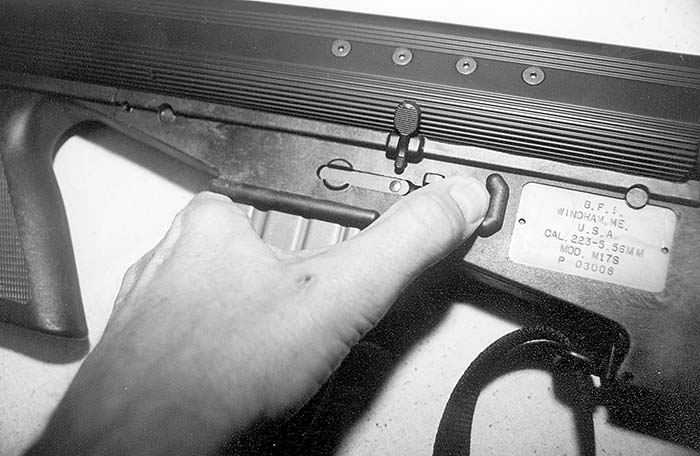
Although it uses the AR-18 operating system, the M17S is otherwise a completely different rifle. The M17S story begins 1982 as a response to an Australian military requirement for a new 5.56x45mm rifle. The initial rifle was developed by Armstech, a small company organized specifically for the purpose of designing and developing a new Australian military rifle. In the face of almost overwhelming odds, Armstech presented the Australian government with a rifle design, test weapons, and full technical data package in a matter of only a few months. There were four other Australian competitors for the new rifle, but the government selected two foreign designs for the final competition – the American M16A2 and Austrian Steyr Armee Universal Gewehr (AUG). The latter was eventually selected as Australia’s service rifle and the indigenous weapons were all but forgotten.
Armstech, however chose to pursue the design of its rifle for export sales and proceeded with development of the C30R, an advanced technology rifle using caseless ammunition. Although the concept of the C30R was highly publicized in Australia, it was developed in haste and premature demonstration before full development in front of news media led to the worst nightmare of the gun developer – poor reliability and an explosion while the rifle was being test fired, apparently an “out of battery ignition.” This disaster led eventually to the demise of Armstech, but not before the firm had decided to pursue a conventional rifle with the basic features of the C30R. The company went into receivership in 1990 after having transferred rights to the rifle to Keith Greenwood of Edenpine, where it was developed into the Sak 30, the direct ancestor of the M17S. By June 1990, the name of the rifle had changed again, this time to ART 30 and the salient features of the M17S were essentially in place. The prototype rifle was tested in Guns Australia and received a highly favorable review, but the handwriting was on the wall as far as sale of firearms in Australia was concerned and Edenpine’s management realized that while the primary market for the rifle would be the United States, restrictions there would make importing it difficult and so Edenpine began searching for a US manufacturer to produce the rifle. An agreement was reached with Bushmaster, who completed development of the rifle, redesignated it M17S and began producing it for domestic sale in early 1994.
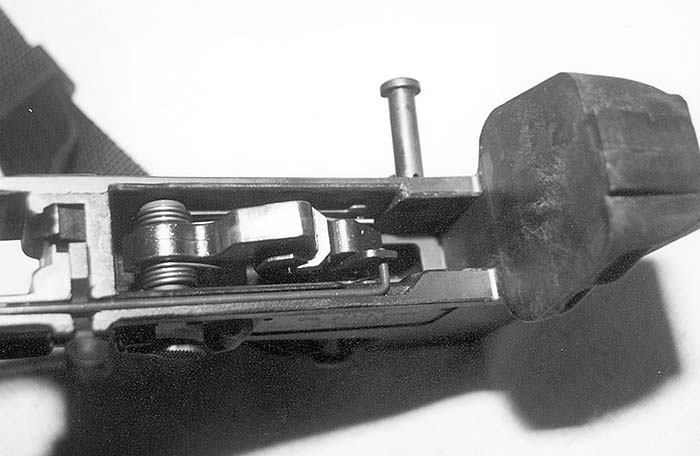
The original Bushmaster rifles can be distinguished by a flat black finish and short throw captive retaining pins to retain the upper and lower receivers. After the second year of production, the upper receiver external finish was changed to matte Teflon. During the third production year, a long throw captive pin retaining system for the upper and lower receivers was implemented, upper receiver weight slightly reduced and a steel cam pin track was added. In the wake of the Great Clinton Semiautomatic Rifle Ban of 1994, some changes were necessary to make the M17S legal for civilian ownership. The only visible change to Post Ban rifles is the lack of a flash hider. To preclude installation of a nefarious and deadly illegal flash hider, the barrel was shortened slightly and the length of threads at the muzzle end reduced so that if a muzzle device was installed, it would not stay in place. There were also some improvements made to the “post ban” M17S rifles. Emergency open sights were installed, the trigger linkage was improved and a new optical sight mount was added.
The M17S is a bullpup design. Many shooters do not like bullpups, usually because they fear that a “catastrophic failure” – a rupture of the barrel or blowing the bolt out will injure them. With the M-17S, such an event is unlikely, and even if it were to occur, the upper receiver is a one-piece tube of extruded aircraft aluminum that is approximately 1/8 inch thick, which should contain any unlikely explosive failures. The lower receiver of the M-17S is molded polymer. Although it is quite different than either the AR-15 or AR-18, those familiar with the other rifles will find operation of the M-17S to be virtually identical to the AR-15/M16. The non-reciprocating charging handle is atop the upper receiver and actually forms the aft portion of the carrying handle. The magazine release is virtually identical to that of the M16, save for the fact that it is ambidextrous – there is a button on both sides of the rifle, which is very handy when removing the magazine using the left hand and thumb. The bolt release is also virtually identical to that of the AR-15/M16 and functions in precisely the same manner. Other than appearance, the only real difference between the manual of arms for the M-17S and the AR-15/M16 is not having to remember to close the ejection port cover after releasing the bolt.
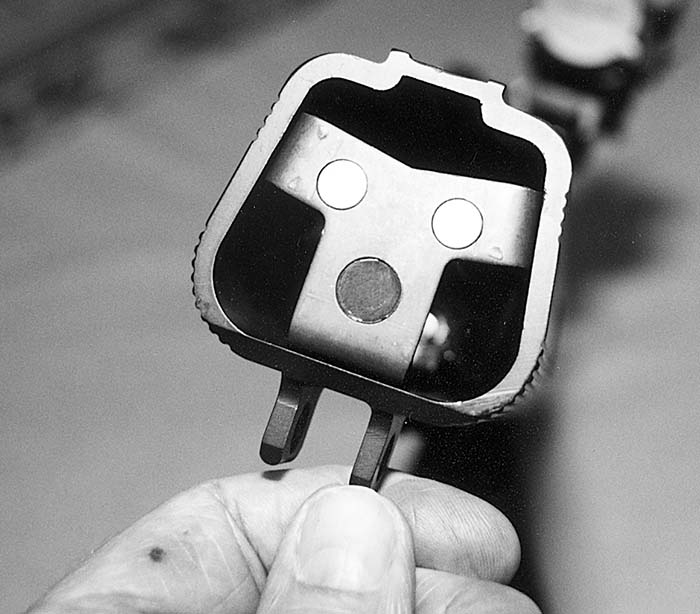
The M-17S uses standard AR-15/M16 magazines. The rifle is provided with one Bushmaster 30 round magazine from the factory, but we used many types of M16 magazines during the course of our evaluation and had not a single malfunction, although we fired the M-17S with every type of 5.56mm ammo we could find, from 40 grain frangible ball to 68 grain match. The M-17S functioned absolutely flawlessly over hundreds of rounds and was highly praised by all who had the opportunity to fire it.
Operation of the M-17S, is as mentioned, straightforward and essentially identical to the AR-15/M16. In fact, the only difference is the location and operation of the safety, which is a simple crossbolt located just behind the trigger that is easily engaged or disengaged using the thumb or forefinger without changing grip. Once engaged, it physically blocks the trigger. A red dot indicates that the rifle is ready to fire, while “safe” is indicated by a white dot on the rear of the safety button. The fact that the safety does not block the rifle’s sear or hammer may be a point of complaint for some, however. The single-stage trigger of the M-17S breaks at about 8.5 LB, heavy enough to avoid potential accusations of having “hair triggers,” but it doesn’t feel as heavy in actual use. I estimated it to be approximately six pounds until I checked it with the trigger scales. Some users may wish to have a “trigger job” performed on their rifles, but we do not believe that it is necessary, as the M17S is not intended to be a precision match rifle. The M-17S’ trigger is actually better than some AR-15/M16 rifles fired by the author in terms of creep and “break,” despite the long connecting rod running back from the trigger to the sear.
Disassembly of the M-17S is similar to the AR-15, except that the M-17S has three push pins, rather than two. The two rearmost pins are pressed out from the left side of the rifle until they run against their stops. The upper receiver can then be pivoted forward and the bolt carrier assembly removed. There is no further disassembly required, nor is any recommended for routine maintenance. The bolt carrier assembly has a built in buffer mounted on the action plate at the rear of the bolt carrier group which absorbs the shock of the bolt carrier as it reaches its rearmost position. Since there is no carbon “blowback” into the receiver of the M-17S, normal cleaning consists of wiping the interior of the receiver, bolt, bolt carrier and locking lugs with a rag or patches. The bore is cleaned via the usual method and that is it. Cleaning an M17S requires none of the pipe cleaners, dental picks, reamers or any of the other paraphernalia necessary to clean an M16. With the M-17S, all that is required is a cleaning rod, patches, solvent, a soft rag, a small brush to ensure that the locking lugs are clean and gun oil. The latter is used to lube the action rods on which the bolt carrier rides (2 drops each), the locking lugs and the camming slot that unlocks the bolt as the carrier moves to the rear. According the manufacturer, the gas system requires no maintenance whatsoever.
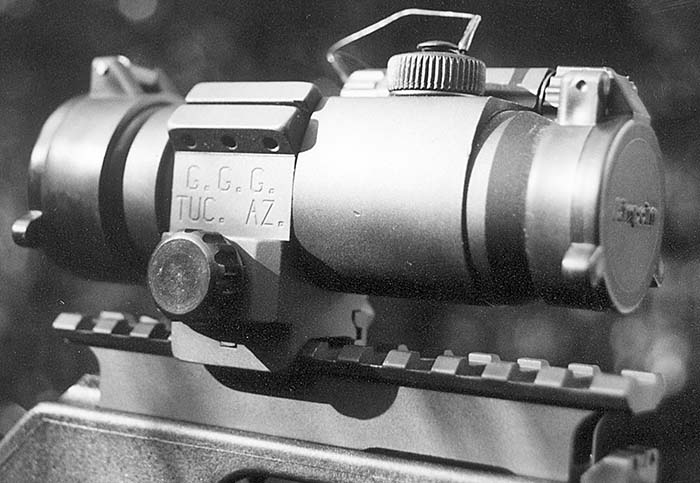
As to the utility of the M-17S for self defense and law enforcement work, it has a lot going for it along with a few shortcomings. First and foremost, the little rifle is handy! The M17S’ overall length of 30 inches is shorter than 16 inch barreled CAR-15s or M4 Carbines with stock collapsed, while the M-17S has a full 21.5 inch chrome plated barrel! This makes it an ideal size for use in a vehicle or on a camping trip, where space is at a premium and deployment of any long gun generally makes exiting a vehicle or enclosure cumbersome. The M-17S can be taken by the pistol grip and deployed essentially “at the ready.” The placement of the pistol grip at the balance of the rifle enables it to also be comfortably carried and fired with one hand if necessary, unlike M4s or CAR-15s, which are awkward and muzzle heavy at best when fired in the this mode. We cannot overemphasize the outstanding balance and overall handling of the M17S. Another benefit of the M-17S is price. Suggested retail of the rifle is approximately $700, although the author has occasionally seen M17S for less.
The M-17S is not without its faults, however. First, it cannot be fired by left-handed shooters due to placement of the ejection port, a problem inherent with most bullpup designs. Second, an after-market sight of some sort is virtually mandatory, which adds to the expense of the rifle. Sights on the M-17S can charitably be described as rudimentary, although the “tunnel” through which the shooter must look in order to use them forms something of a very large “ghost ring” that might be used for very close engagements. Nonetheless, we feel that an after-market sight is virtually mandatory. The M-17S has a military standard “Picatinny rail” and thus will accept all Weaver-type mounts. We used an Aimpoint Comp ML with GG&G’s excellent mount that not only positions the sight lower than the factory original, but has space for a spare battery as well. With the Comp ML installed, we were able to engage targets from CQB distance out to 200 meters without difficulty. A sight such as the Aimpoint, EO Technology’s Holographic sight, or Trijicon’s ACOG is of great benefit because sight alignment is eliminated and there is no parallax, enabling the shooter to simply place the red dot or cross hair on the target and shoot. This type of sight also greatly enhances the speed of target acquisition. If the rifle is properly zeroed, the bullet will strike nearly at point of aim at typical carbine engagement ranges of 25 to 100 meters, with “Kentucky windage” enabling quick and easy 200 to 300 meter engagements. Optical sights such as those mentioned are also of great benefit to individuals whose eyes, like those of the author, make the use of iron sights difficult due to their inability to focus on close objects.
We tested the M17S using the Aimpoint Comp ML at 100 yards and were able to achieve 2.5 inch groups from a rest using Black Hills and Remington 62 grain match ammunition. We also tested the rifle using Longbow 40 grain frangible and Cor-Bon 52 grain ball ammunition and achieved groups that ran in the three to 3.5 inch range. Considering that the Aimpoint dot virtually covered the standard bullseye at 100 yards, we considered the accuracy of the M17S to be excellent. We suspect that with appropriate sights the little rifle could probably group in the 1.5 inch range, but we did not have time to test this aspect of the rifle. Bushmaster has graciously agreed to allow us to keep our test M17S for an extended evaluation over the coming year, so we will be conducting some experiments with sights other than the Aimpoint and a few other modifications as well. Plus, we will be reporting on the overall reliability of the rifle under extended use.
In sum, we find a lot to like about the M17S, along with a few shortcomings. The little rifle is probably the best balanced and handling rifle we have fired in many years. Its ergonomics are superlative with one exception. Under sustained fire, the forearm tends to heat up, a problem which was only partially ameliorated by the installation of a home workshop fabricated heat shield. The only solution is to move the supporting hand back to the forwardmost part of the polymer lower receiver. Most of those who fired the rifle did not find this inconvenient or uncomfortable; in fact, many felt that it was a better position than a more conventional one with supporting hand under the forearm. Moreover, everyone who fired the M17S was taken with just how enjoyable the rifle was to shoot, a tribute to the overall excellence of its design.
In sum, Bushmaster’s M17S is a highly reliable and compact rifle best suited for carry or storage in vehicles or in locations where space is at a premium. It is a short range – i.e. 25-300 yard – rifle, the distances at which most land combat occurs. The rifle is ideal for its intended purposes, which are self protection and informal shooting. Because of its size, it makes an nearly perfect vehicle or camp rifle. For the same reasons, the M17S is ideally suited as a law enforcement carbine, a role in which it far outclasses pistol – caliber carbines now offered by other manufacturers. In the final analysis, while the M17S has a few shortcomings, we believe that these are far outweighed by its attributes.
| This article first appeared in Small Arms Review V2N7 (April 1999) |



